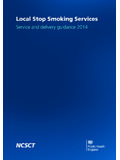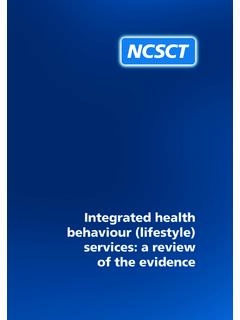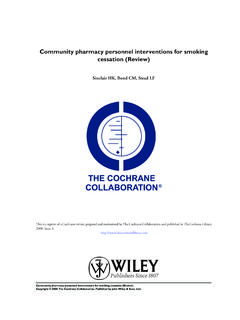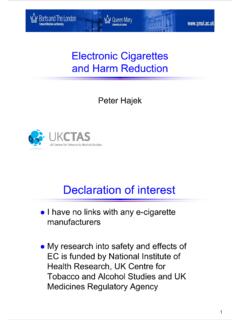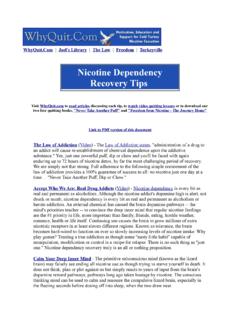Transcription of The effectiveness of NHS smoking cessation services: a ...
1 The effectiveness of NHS smoking cessationservices: a systematic reviewLinda Bauld1, Kirsten Bell2, Lucy McCullough2, Lindsay Richardson2, Lorraine Greaves21 Department of Social and Policy Sciences and UK Centre for Tobacco Control Studies, University of Bath, Bath, UK2 British Columbia Centre of Excellence for Women s Health, Vancouver, CanadaAddress correspondence to Linda Bauld, E-mail: analyse evidence on the effectiveness of intensive NHS treatments for smoking cessation in helping smokers to systematic review of studies published between 1990 and 2007.
2 Electronic databases were searched for published reports were identified from the national research register and studies were included. They suggest that intensive NHS treatments for smoking cessation are effective in helping smokers to national evaluation found 4-week carbon monoxide monitoring validated quit rates of 53%, falling to 15% at 1 year. There is some evidencethat group treatment may be more effective than one-to-one treatment, and the impact of buddy support varies based on treatment on the effectiveness of in-patient interventions is currently very limited.
3 Younger smokers, females, pregnant smokers and more deprivedsmokers appear to have lower short-term quit rates than other research is needed to determine the most effective models of NHS treatment for smoking cessation and the efficacy of thosemodels with subgroups. Factors such as gender, age, socio-economic status and ethnicity appear to influence outcomes, but a current lack ofdiversity-specific analysis of results makes it impossible to ascertain the differential impact of intervention types on particular , gender, NHS stop smoking services , smoking cessation , smoking treatment, systematic reviewIntroductionCigarette smoking remains the leading cause of preventabledeath in England today.
4 It is estimated to be responsible forup to 86 500 deaths per year1and costs the National HealthService (NHS) between approximately and billionpounds the publication of the White PaperSmoking Kills,3the UK government has demonstrated astrong commitment to reducing smoking prevalence4through the implementation of an advertising ban, increasesin the price of tobacco, a ban on smoking in workplacesand enclosed public places and the creation of a nationalnetwork of smoking cessation services known as NHSstop smoking stop smoking services represent a unique nationalinitiative to provide support for smokers motivated 6 The service provision framework employed by thesmoking cessation clinics was originally based on theMaudsley model,7an evidence-based approach to treatingdependent ,9 This approach entails regularmeetings (group or one to one)
5 With a trained adviser usingstructured, withdrawal-oriented behavioural therapy com-bined with smoking cessation medications such as nicotinereplacement therapy (NRT), bupropion or the establishment of the services , the Department ofHealth (DH) has required individual primary care trusts(PCTs) in England to monitor the effectiveness of their localservices. This involves regular reporting of the number ofpeople setting a quit date and the number of 4-week monitoring data provides an overview of the volume ofclients treated by the services (over 2 million people between2003 and 2007)
6 But has a number of limitations, not least theLinda Bauld, Professor of Social PolicyKirsten Bell, Tobacco Research CoordinatorLucy McCullough, Research AssistantLindsay Richardson, Research Co-ordinatorLorraine Greaves, Executive Director, BC Centre of Excellence for Women s Health#The Author 2009, Published by Oxford University Press on behalf of Faculty of Public Health. All rights of Public Health | pp. 1 12 | Journal of Public Health Advance Access published July 28, 2009fact that it relies on self-report rather than carbon monoxidemonitoring (CO)-validated ,11In addition to routine monitoring, the DH commissioneda national evaluation of the NHS stop smoking services inEngland between 2001 and 2004.
7 Results were published inAddictionin ,13As part of the process of developingsmoking cessation guidance in England,14the NationalInstitute for Health and Clinical Excellence (NICE) com-missioned a systematic review of existing evidence and thisarticle describes findings from this review. The review aimedto analyse available evidence on the effectiveness of inten-sive NHS treatments for smoking cessation and to considerthe differential impact of treatment on subpopulations. Thereview therefore reports findings on the effectiveness of ces-sation interventions in clinical, as opposed to research, set-tings.
8 As such, and in contrast to other reviews of smokingcessation interventions, it provides evidence of effectivenessin real-world methodsThe review was conducted in May 2006 with an update inNovember 2007. The literature search was carried out bythe Centre for Reviews and Dissemination at the Universityof York. Articles from 1990 to 2007 written in English weresearched in the following bibliographic databases: CochraneDatabase of systematic Reviews, Database of Abstracts ofReviews of effectiveness , Health Technology AssessmentDatabase, National Research Register (including CRDongoing reviews database), SIGN Guidelines, NationalGuideline Clearinghouse, HSTAT, TRIP and , because the services have been in existence forless than 10 years, it was expected that some relevant studieswould be found in the grey literature.
9 Grey literature wasaccessed through three avenues: (i) the National ResearchRegister; (ii) the smoking cessation services ResearchNetwork and (iii) tobacco control experts within academiaand be included in the review, studies had to fulfil each ofthe following criteria:(i) They had to examine smoking cessation interventionsprovided within the NHS in the UK. Although thereview focused on England, studies from other parts ofthe UK were included.(ii) The interventions had to be moderately intensive orintensive interventions conducted through the NHS;brief interventions (such as brief advice to stopsmoking by a health professional) were not literature search generated 5131 citations.
10 Before acquiringpapers for assessment, titles were initially scanned by onereviewer who removed the irrelevant studies. The remaining292 abstracts were independently scrutinized by two reviewersand those that did not fulfil the inclusion criteria were elimi-nated. Sixty-nine studies, reports and reviews remained andwere acquired for assessment. Upon examination of the fullarticles, 14 published studies met the inclusion criteria for thisreview. A further 25 reports were acquired through the greyliterature search, and 6 met the inclusion criteria.
![e-cigarettes briefing [ 2 ] v4 - NCSCT](/cache/preview/0/6/5/c/9/3/f/f/thumb-065c93ffb7496a6f7f874369520a6a6d.jpg)



